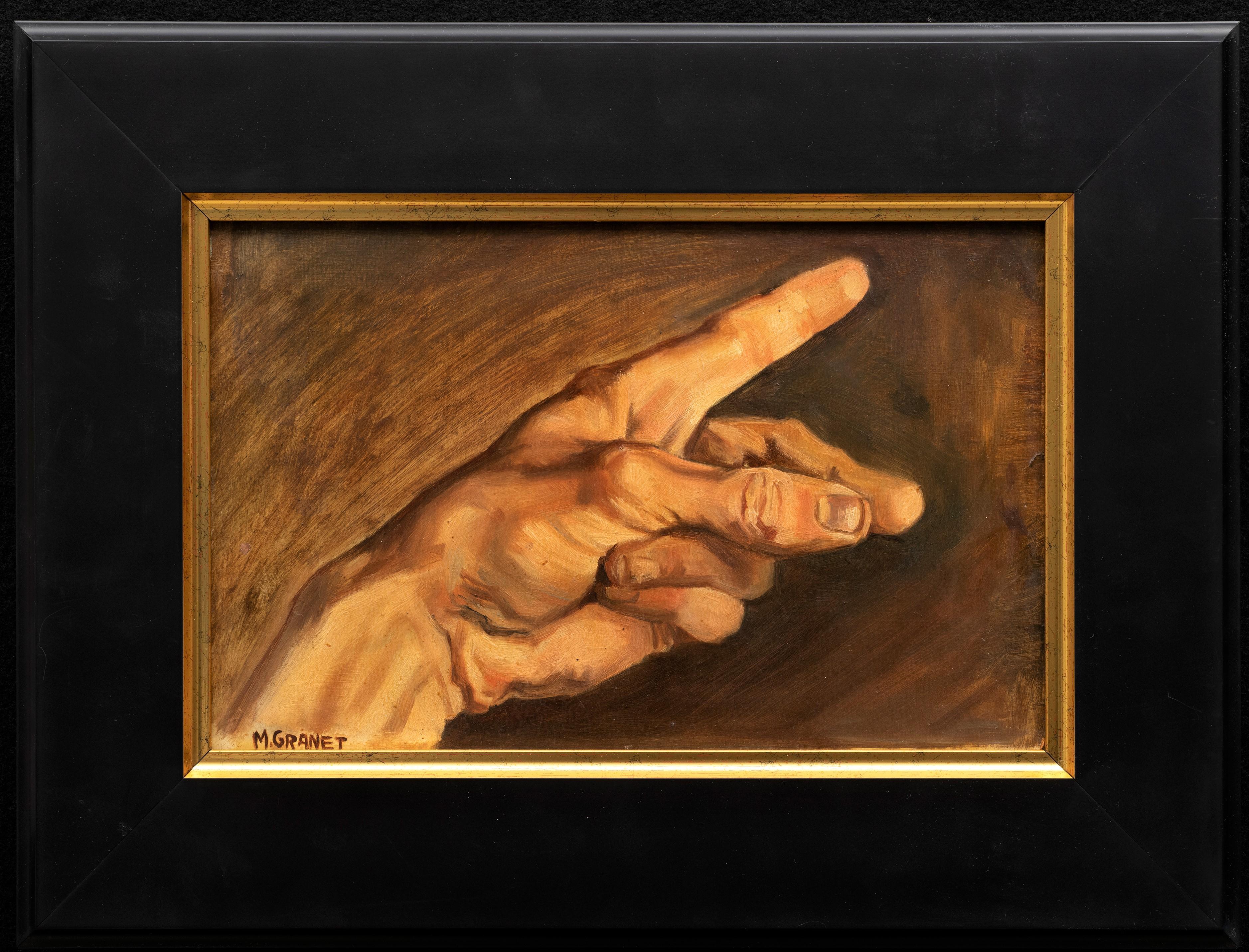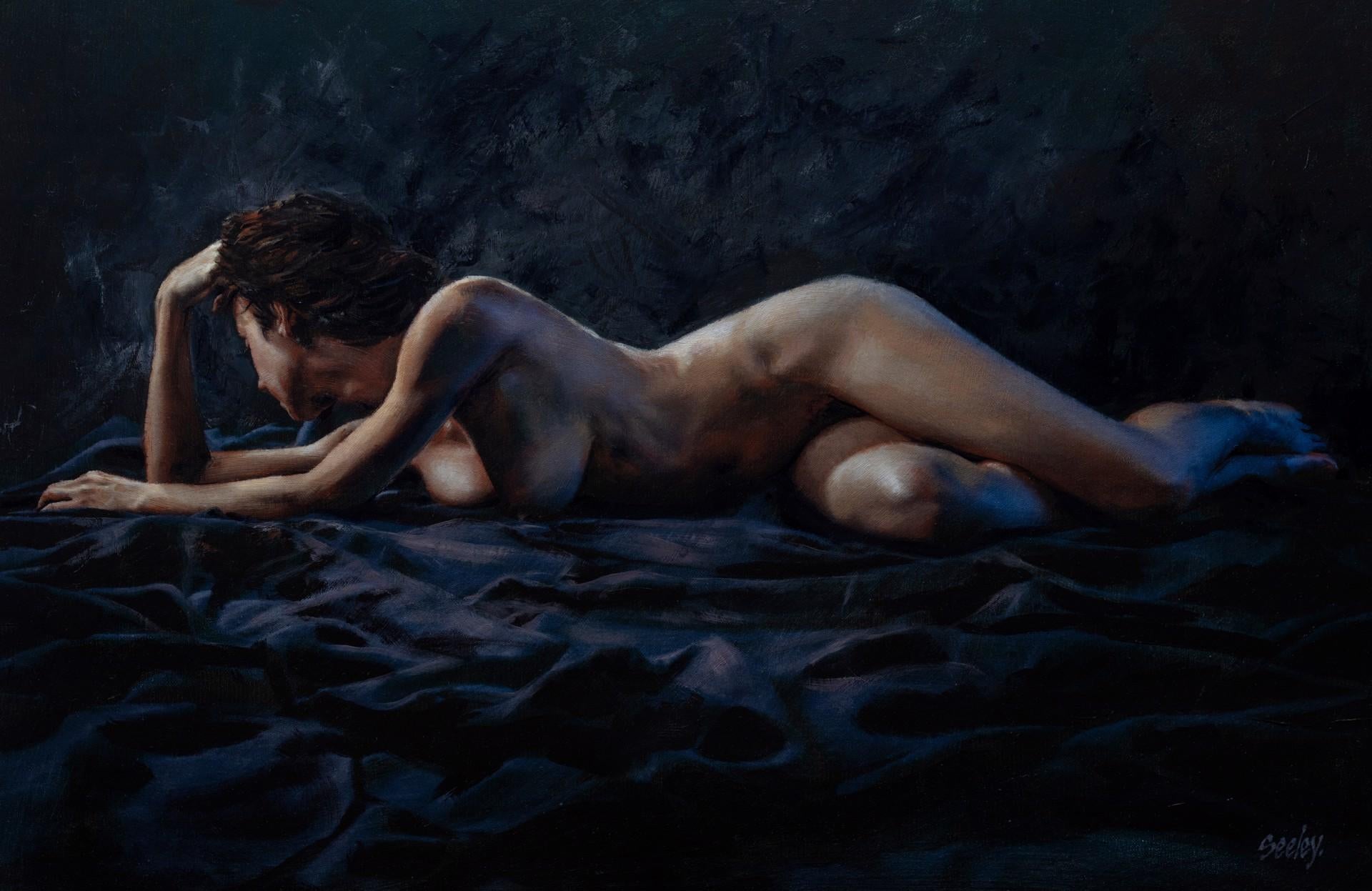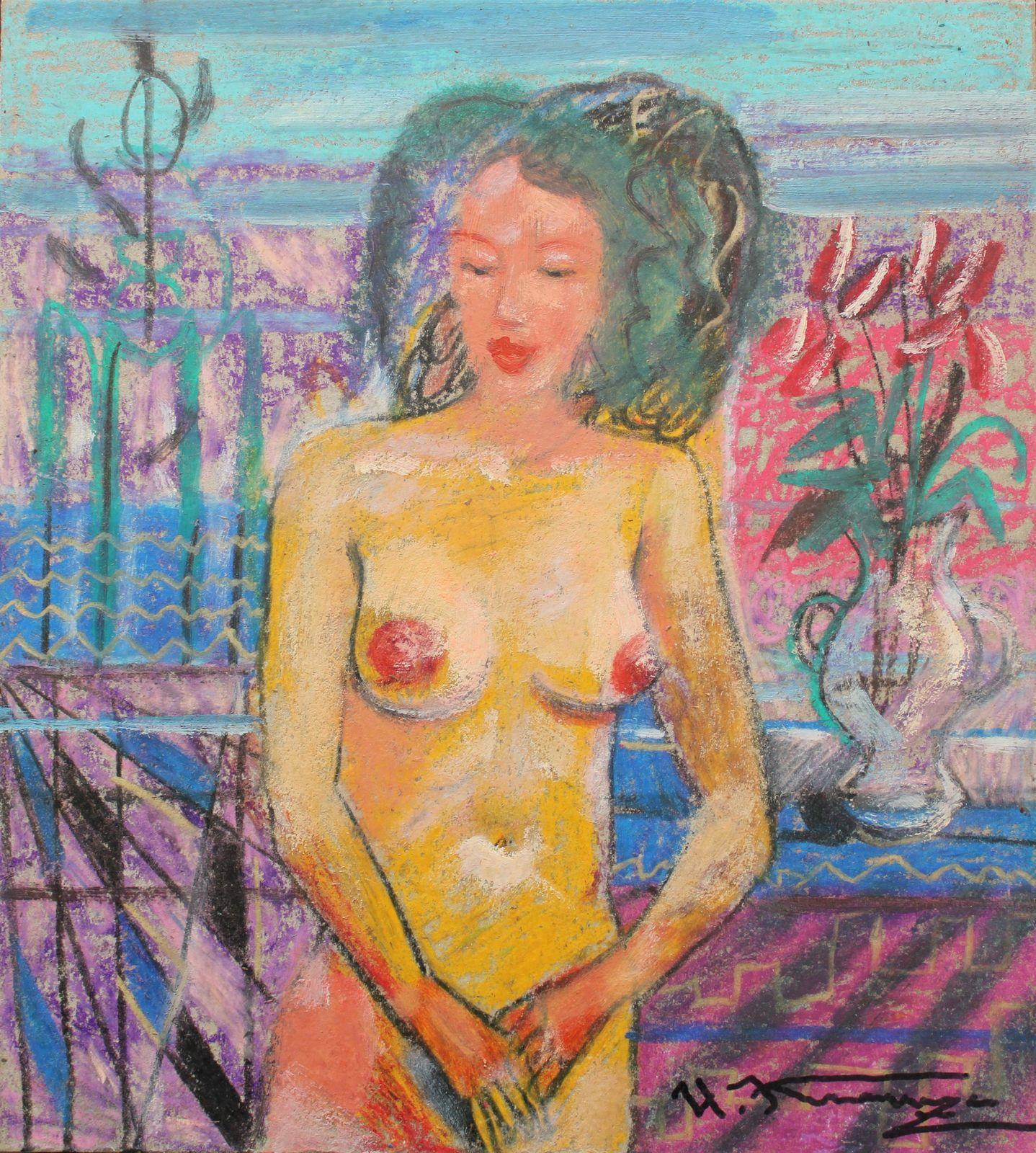Items Similar to Act. 1979. Oil on cardboard, 96x70 cm
Want more images or videos?
Request additional images or videos from the seller
1 of 18
Alfejs BromultsAct. 1979. Oil on cardboard, 96x70 cm1979
1979
About the Item
Act. 1979. Oil on cardboard, 96x70 cm
Alfejs Bromults (1913.3.IV - 1991.11.I)
His first professional education was at National University at studies to R.Suta, J. Bine and G. Skilters. Still 1938 he learned at academy of Art in Latvia 1940 – 1944. His graduating work “a fair” was not ended, because it was not possibility at time of 2 World war.
- 1935 – 1936 - in Latvian army;
- 1936 – 1940 - retouched a photography;
- 1944 – 1945 - legionary struggles at Kurland.
- 1948 – 1952 – worked at Combine ,, Maksla ‘’, at portrait studio
Exhibitions:
Since 1943.
Solo exhibitions: Tukums 1959, Riga 1959, 1976, 1987, 1988. Cesis, Madona 1960, Dobele 1963, Rezekne 1964, Joniski (Lithuania) 1976, Suhumi, Abhazia 1977, Roja 1978, Limbazi 1981, Liezere 1983, Saldus 1988.
His works have been exhibited abroad - in Russia (Moscow), Australia, USA, England and Finland.
Memorial exhibition:
Riga, Church of Peters 1991.
Member of Artists Union.
He painted portraits, landscapes, flowers; his painting manner was realism.
- Creator:Alfejs Bromults (1913 - 1991, Latvian)
- Creation Year:1979
- Dimensions:Height: 37.8 in (96 cm)Width: 27.56 in (70 cm)Depth: 0.79 in (2 cm)
- Medium:
- Movement & Style:
- Period:
- Condition:
- Gallery Location:Riga, LV
- Reference Number:1stDibs: LU143727037392
Alfejs Bromults
Alfejs Bromults (1913.3.IV - 1991.11.I) His first professional education was at National University at studies to R.Suta, J. Bine and G. Skilters. Still 1938 he learned at academy of Art in Latvia 1940 – 1944. His graduating work “a fair” was not ended, because it was not possibility at time of 2 World war.
- 1935 – 1936 - in Latvian army;
- 1936 – 1940 - retouched a photography;
- 1944 – 1945 - legionary struggles at Kurland.
- 1948 – 1952 – worked at Combine ,, Maksla ‘’, at portrait studio
Exhibitions:
Since 1943.
Solo exhibitions: Tukums 1959, Riga 1959, 1976, 1987, 1988. Cesis, Madona 1960, Dobele 1963, Rezekne 1964, Joniski (Lithuania) 1976, Suhumi, Abhazia 1977, Roja 1978, Limbazi 1981, Liezere 1983, Saldus 1988. His works have been exhibited abroad - in Russia (Moscow), Australia, USA, England and Finland. Memorial exhibition:
Riga, Church of Peters 1991.
Member of Artists Union.
He painted portraits, landscapes, flowers; his painting manner was realism.
About the Seller
5.0
Platinum Seller
These expertly vetted sellers are 1stDibs' most experienced sellers and are rated highest by our customers.
Established in 2002
1stDibs seller since 2020
144 sales on 1stDibs
Typical response time: 8 hours
- ShippingRetrieving quote...Ships From: Riga, Latvia
- Return PolicyA return for this item may be initiated within 7 days of delivery.
More From This SellerView All
- Morning. Women's act. 1959. Oil on cardboard, 95x71 cmBy Alfejs BromultsLocated in Riga, LVThe morning hour. Act. 1959. Oil on cardboard, 95x71 cm Alfejs Bromults (1913.3.IV - 1991.11.I) His first professional education was at National University at studies to R.Suta, J....Category
1950s Realist Nude Paintings
MaterialsCardboard, Oil
- Shyness. Cardboard, author`s technique, 31x28 cmLocated in Riga, LVShyness Cardboard, author`s technique, 31x28 cmCategory
Early 2000s Impressionist Nude Paintings
MaterialsCardboard, Oil, Mixed Media, Pastel
- Girl with red hair. 1996. Oil on cardboard, 90x83 cmLocated in Riga, LVGirl with red hair. 1996. Oil on cardboard, 90x83 cm This depiction of young nude woman with red hair on green-pink-blue background shows the artist as a master of forms and color field areas. Laimdots Murnieks...Category
Late 20th Century Modern Figurative Paintings
MaterialsCardboard, Oil
- Dreamer. 1996. Oil on cardboard, 83x90 cmLocated in Riga, LVDreamer. 1996. Oil on cardboard, 83x90 cm This depiction of young nude woman lying down on green blue surface shows artist Laimdots Murnieks as a master of forms and color field are...Category
Late 20th Century Modern Figurative Paintings
MaterialsOil, Cardboard
- Girl friends 2010, cardboard, author's technique, 31x21.5 cmLocated in Riga, LVGirl friends 2010, cardboard, author's technique, 31x21.5 cmCategory
2010s Impressionist Figurative Paintings
MaterialsOil, Cardboard
- Two dancers. Cardboard, oil, 34x23 cmLocated in Riga, LVTwo dancers Cardboard, oil, 34x23 cmCategory
Early 2000s Impressionist Nude Paintings
MaterialsOil, Cardboard
You May Also Like
- 19th Century French Academic Study of a HandLocated in SANTA FE, NMFrench Academic Study of a Hand Circa 1900 Oil on Cardboard 13 3/8 x 8 3/8 (19 1/8 x 14 1/8 frame) inches Signed lower left "M. Granet" A very finely...Category
Early 1900s Realist Figurative Paintings
MaterialsCardboard, Oil
- "Nude, " Arnold Blanch, Woodstock School, WPA, FigurativeBy Arnold BlanchLocated in New York, NYArnold Blanch Nude Signed lower right Oil on board 20 x 16 inches Provenance: G. David Thompson Collection, Pittsburgh Private Collection, New York Bo...Category
1930s Realist Nude Paintings
MaterialsBoard, Oil
- Audrey #1Located in Denver, CODave Seeley's "Audrey #1" is an original, handmade oil painting that depicts a nude female model reclining on blue velvet fabric as she turns her face away from the viewer.Category
21st Century and Contemporary Realist Figurative Paintings
MaterialsCanvas, Oil, Board
- Nandor Vagh Weinmann, Oil on cardboard, Naked Back, 1930sLocated in Saint Amans des cots, FROil on cardboard by Nandor VAGH WEINMANN (1897-1978), France, 1930s. Naked back. With frame: 64x56 cm - 25.2x22 inches ; without frame: 46x38cm - 18.1x15 inches. 8F format. Signed "Nandor V. Weinmann" lower left. In its Montparnasse frame. Very good condition. Born October 3, 1897 in Budapest, Nándor is the older brother of Elemer and Maurice Vagh-Weinmann. He came to Paris to present his work in 1931. He died on December 12, 1978 near Montereau (Seine-et-Marne) following an automobile accident. He is the most colorful of the three “expressionist” brothers. Painter of figures, landscapes, especially open mountains, and bouquets in bright colors. He is also a religious painter and then finds the tragic condition. Born in BUDAPEST on October 3, 1897, Nandor Vagh Weinmann belongs to a profoundly artistic people. Living in the heart of Central Europe where they came from Asia a millennium ago, the Hungarians have preserved a strong ethnic individuality whose mark is their very synthetic, non-Indo-European language. Resistant to secular invasions, they have kept the virtues of a very ancient humanity that have become rare in our modern world, especially since their way of life has remained essentially rural until today. In the arts they know how to express a generous, extreme sensibility and by the poetic verb, by the musical rhythms and also by a popular art of a richness, an exceptional harmony. Until the age of thirty-four, during the decisive years of childhood and youth, Nandor Vagh Weinmann was intimately imbued with popular life and the soul of Hungary. From the capital where his father was a jeweler and had a family of ten children, Nandor was the fifth, he knew first of all the suburbs, the populated districts, the rigors in winter of the cold and the snow. A very mobile existence made him acquainted with all of Hungary, from the Danube to Transylvania, its infinite plains and its wild mountains, its immense villages with ample low houses, and its towns which are still immense villages. The painter is passionate about rustic works, harvest scenes, beautiful folk costumes. Coming into direct contact with the peasants, he learned to know their soul. These contacts gave the artist a direct feeling for popular life and soul, as Millet once understood the peasants of Barbizon and Normandy whose existence he shared. What fascinated Nandor Vagh Weinmann above all were the festivals which enlivened the dreary life of the countryside, the circuses, the merry-go-rounds, the gypsies unleashing orgies of music, light and color. In the party, and especially the Hungarian party, the whole soul of a people, all its energy, its need for movement, for intensity, is expressed in its pure state and realizes the primary and essential form of what is called beauty. And as if melted at the party, there is the infinite steppe where herds of horses and oxen circulate where terrible storms sometimes roar where the seasons unfold their grandiose splendours. The young Nandor Vagh Weinmann nourishes his sensitivity to his inexhaustible shows, both eternal and always new, a sensitivity which very early declared itself that of a painter. Since the age of fourteen he painted, and since then he never stopped doing it. Two of his brothers Maurice, two years his junior, who had a remarkable career similar to that of Nandor and later Elemer who became Maurice's pupil, also devoted themselves to painting, despite family obstacles. And the three brothers united by a common passion worked together in Hungary and later in France. Painting was so much in the blood of the family, as in the past among the Veroneses, the Breughels, the Lenains, the Van Loos and so many other artistic dynasties, that three sons of the Vagh Weinmanns became painters in their turn. One of these, Emeric, son of Nandor, today occupies an important place in the contemporary school. Nandor, at fifteen, was a pupil of the Academy of Fine Arts in Budapest where he worked diligently, then at that of Vienna. He painted many portraits, but also landscapes, compositions and, by his relentless work, managed to live from his brush, although married very young and having to overcome many hardships. He therefore knew the hardships and miseries of life. These strongly impregnated his vision as an artist and explain the thrill of humanity that runs through all his work. A particularly moving experience was reserved for him at the age of twenty. In the hospitals of Budapest he had to paint extraordinary cases, operations, frightful wounds, the deformations to which our poor body is subjected by traumas and physiological decompositions. In these circumstances, it is not a question of gratuitous art, of formal research but of immediate, authentic expressions of our flesh and our being. We know that Breughel Velázquez and Goya had been haunted by the sight of cripples and of madmen Géricault by that of corpses. But life is ultimately stronger than anything, and it is life that Nandor Vagh Weinmann has passionately observed and translated through all the places where he has always painted on nature. Nothing stopped him. It happened to him to paint, for example in front of the mill of Linselles by a weather so cold, that nobody could stay outside, and that he did not leave the place before having finished his work. Because he works constantly on the ground, under the sky, in the silence he loves. His reputation is established. He exhibited at the national fair in Budapest, in the big cities of Hungary Szeged, Szombathely, Veszprém, Kaposvar. In 1931, like all artists in the world, he came to France. But unlike the others, he did not settle in Paris. Because Nandor Vagh Weinmann does not belong to this group of cosmopolitans that we call the School of Paris. He settled in Toulouse, where he remained for a long time with his brothers, and traveled throughout France, eager for new ties, exhibiting in the most diverse cities, in Bordeaux, Marseille, Lyon, Agen, Bayonne, Dax, Tarbes, Grenoble, Nice, Cannes, Strasbourg, Mulhouse, Colmar, Lille. He even crossed borders. He was in Saint Sebastian, in Geneva, and once in Egypt in 1927 where he painted King Fouad...Category
1930s Expressionist Figurative Paintings
MaterialsOil, Cardboard
- Mid Century Sitting Nude FigurativeBy Elmer AlbrittonLocated in Soquel, CAMid Century figurative painting of a pensive sitting nude figure with moody, mid-century color palette in the background. Attributed to Elmer S. Albritton, unsigned (American, 1922-...Category
1960s American Modern Nude Paintings
MaterialsCanvas, Oil, Cardboard
- Mid Century Abstract Expressionist Grey FigurativeBy Louis NadaliniLocated in Soquel, CAAbstract expressionist nude figure by Louis Nadalini (American, 1927-1995). Signed "Louis Nadalini" in the lower right corner. Signed "Louis Ernie Nadalini" on verso. Unframed. Image...Category
1980s Abstract Expressionist Nude Paintings
MaterialsCanvas, Cardboard, Oil
Recently Viewed
View AllMore Ways To Browse
Vintage Act
Russian Oil Painting Realism
England Church Oil Painting
Roja Art
Peters Oil Painting
World War 2 Usa
J Peters
Vintage Madona
Alfejs Bromults
Winifred Elizabeth Beatrice Hardman
Balbyshev Oleksandr
Ellina Zhanu
G Tibbles
Georgette Nivert B1900 Early 20th Century Oil Dreaming
Hayley Mitchell
Inga Khanarina
Kenne Gregoire
Krzysztof Stepniewski



